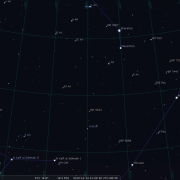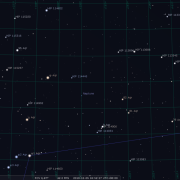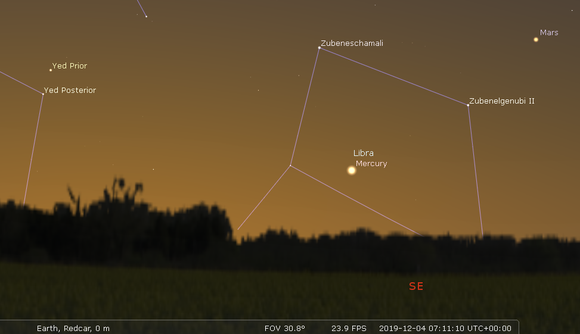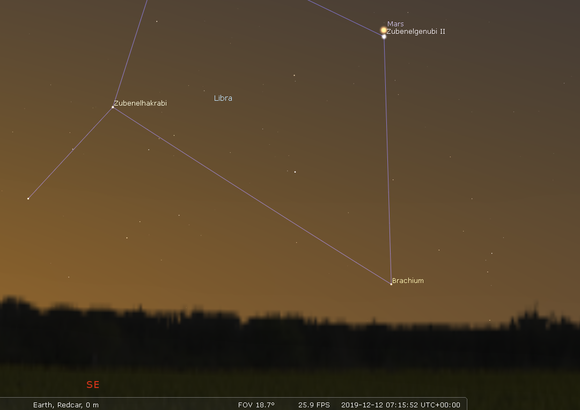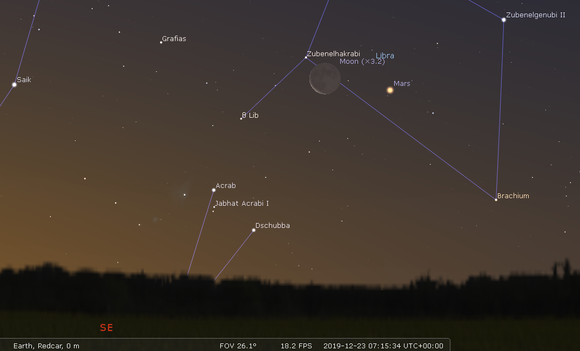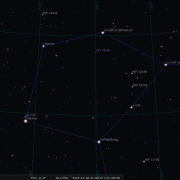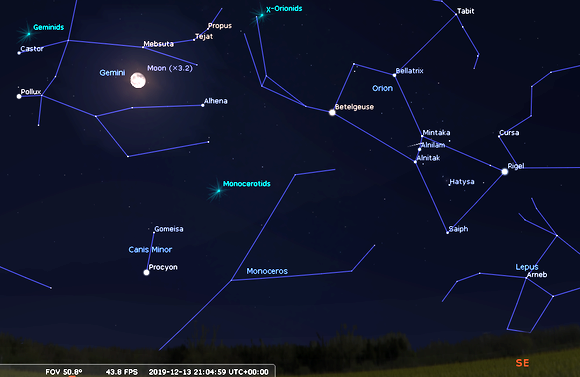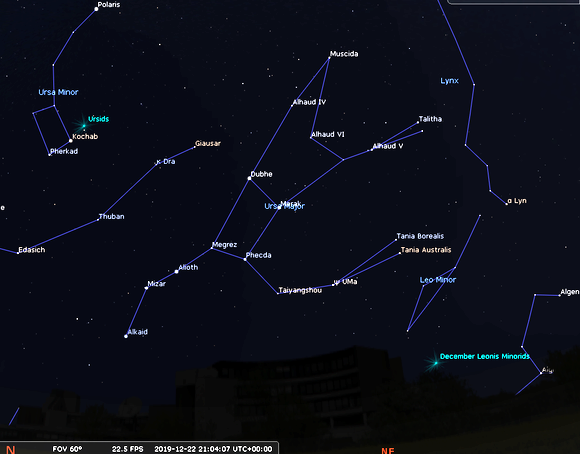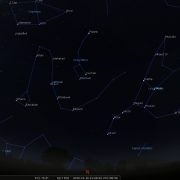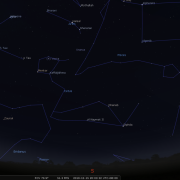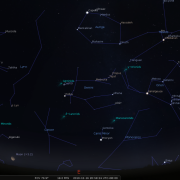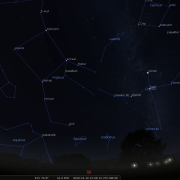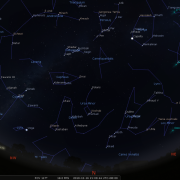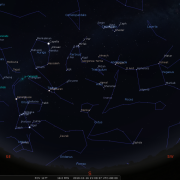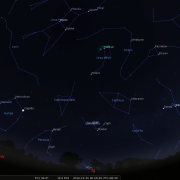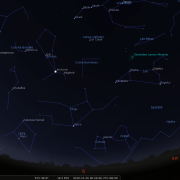In this month's Sky Notes:
Planetary Skylights
Evening Planets
We bid farewell to two planets during December, with Jupiter and Saturn both departing the evening sky, whilst Venus starts to gain in altitude, growing ever more noticeable in the evening twilight. In the dawn sky, Mercury is still visible for the first ten days of December, whilst Mars continues to edge away from the South-East horizon.
 Jupiter is finally lost in solar glare by the end of the first week in December. If you have a clear unobstructed SW horizon you may just spot it half an hour after sunset before it drops below the horizon.
Jupiter is finally lost in solar glare by the end of the first week in December. If you have a clear unobstructed SW horizon you may just spot it half an hour after sunset before it drops below the horizon.
 Venus will grow ever more prominent in the December twilight sky, slowly pulling away from the SW horizon and moving up toward Saturn, which is sliding downwards. The two are closest on the 11th with Saturn upper right of Venus, whilst on the 14th they lie at an equal height above the horizon. View around 16:20h.
Venus will grow ever more prominent in the December twilight sky, slowly pulling away from the SW horizon and moving up toward Saturn, which is sliding downwards. The two are closest on the 11th with Saturn upper right of Venus, whilst on the 14th they lie at an equal height above the horizon. View around 16:20h.

 Saturn continues to slide down toward the horizon and is lost by the end of the month. Look for a very slender crescent Moon in this part of the evening sky from the 27th to 29th.
Saturn continues to slide down toward the horizon and is lost by the end of the month. Look for a very slender crescent Moon in this part of the evening sky from the 27th to 29th.
 Uranus resides in Aries well placed in the SSE during the evening. Although technically visible to the naked eye at Mag +5.8, in reality binoculars, or better still, a telescope are needed to spot it. Uranus resides just within the borders of Aries quite some distance below the ‘crooked line’ asterism of the Ram. If you have a constellation chart or App etc, use Mesarthim and Iota Aries as pointers to locate Uranus, which resides 3 times the distance between these stars and a tad to the right, below them. Through a telescope Uranus resembles a very small disk of subtle grey/green hue.
Uranus resides in Aries well placed in the SSE during the evening. Although technically visible to the naked eye at Mag +5.8, in reality binoculars, or better still, a telescope are needed to spot it. Uranus resides just within the borders of Aries quite some distance below the ‘crooked line’ asterism of the Ram. If you have a constellation chart or App etc, use Mesarthim and Iota Aries as pointers to locate Uranus, which resides 3 times the distance between these stars and a tad to the right, below them. Through a telescope Uranus resembles a very small disk of subtle grey/green hue.
 Neptune resides in the constellation of Aquarius just under a degree lower right of the star phi aqr. You will require a telescope to spot its diminutive disk, which is fainter than all visible naked eye stars, but it does appear blue/grey in hue.
Neptune resides in the constellation of Aquarius just under a degree lower right of the star phi aqr. You will require a telescope to spot its diminutive disk, which is fainter than all visible naked eye stars, but it does appear blue/grey in hue.
Morning Planets
 At the start of December Mercury is actually the second brightest planet on view, and certainly the brightest in the morning sky, but you will require a clear view of the SE horizon to spot it. As the month commences it resides over eight degrees above the horizon, (a tad more than the average 7 x 50 binocular field) but rapidly drops backwards and will be lost once again by the 11th. You will need to view around 07:15h.
At the start of December Mercury is actually the second brightest planet on view, and certainly the brightest in the morning sky, but you will require a clear view of the SE horizon to spot it. As the month commences it resides over eight degrees above the horizon, (a tad more than the average 7 x 50 binocular field) but rapidly drops backwards and will be lost once again by the 11th. You will need to view around 07:15h.
04-Dec-2019 at 07:11h (SE): Mars and Mercury. (Click for full-sized image)
12-Dec-2019 at 07:15h (SE): Mars and Zubenelgenubi. (Click for full-sized image)
23-Dec-2019 at 07:15h (SE): The Moon and Mars. (Click for full-sized image)
 Mars resides upper right of Mercury at the start of December and is slowly moving diagonally away from the SE horizon when viewed at the same time each morning, although it is actually moving down through the stars of Libra. It is the Earth’s daily rotation which compensates for this. On the 12th Mars lies very close to the lovely double star Alpha Libra or Zuben Elgenubi. Binoculars or a telescope will show them well. Look for the crescent moon in this area of the sky on the 22nd and 23rd.
Mars resides upper right of Mercury at the start of December and is slowly moving diagonally away from the SE horizon when viewed at the same time each morning, although it is actually moving down through the stars of Libra. It is the Earth’s daily rotation which compensates for this. On the 12th Mars lies very close to the lovely double star Alpha Libra or Zuben Elgenubi. Binoculars or a telescope will show them well. Look for the crescent moon in this area of the sky on the 22nd and 23rd.
 The minor planet Vesta remains well placed for spotting, residing in the loop of mostly faint stars marking the head of Cetus. Look for it toward the top of the loop not far below mu ceti. At mag + 7.5 Vesta is now beyond naked eye visibility, but binoculars will suffice, with its motion against the background stars betraying its nature. Consecutive observing nights would therefore be helpfull!
The minor planet Vesta remains well placed for spotting, residing in the loop of mostly faint stars marking the head of Cetus. Look for it toward the top of the loop not far below mu ceti. At mag + 7.5 Vesta is now beyond naked eye visibility, but binoculars will suffice, with its motion against the background stars betraying its nature. Consecutive observing nights would therefore be helpfull!
Meteors

Considered the most prolific annual meteor shower, the Geminids are active from December 7-16th, reaching a peak on December 14th. When conditions are favourable observed rates can approach 50-60 per hour, however this year a waning gibbous moon will severely restrict numbers and only the brightest Geminids will be noticeable.
Geminids originate from debris shed by a small asteroid called Phaethon, which may even be the nucleus of a ‘dead’ comet. Phaethon passes within ten million miles of the Sun causing the object to deposit material over great swathes of the inner solar system. However it is only within the last eighty years that Geminid activity has increased to the levels now recorded, a result of Earth passing through a much denser debris strand, a situation that will only continue for another hundred years or so.
A typical Geminid meteoroid is about the size of a large coffee granule, Brighter Geminids regularly produce long luminous trails, sometimes green or orange in hue. The shower radiant lies close to Castor, visible in the east by 21:00h.
Conditions for the less prolific Ursid meteor shower are much more favourable. The shower is active from Dec 17-25th, peaking on Dec 22/23rd, Hourly rates of around 10 are the norm, but occasionally and erratically, Ursids can produce strong outbursts, so it may be worth keeping an eye open that night. The radiant lies close to the Great Bear – Ursa Major.
The Winter Solstice

Winter Solstice in Winksley, North Yorkshire
back in 1998. Photo by Peter Crump.
The Sun reaches its lowest position in the sky on December 22nd, the date of the winter solstice and officially the start of winter in the northern hemisphere. From our latitude, useful daylight amounts to just 7½ hrs ’the shortest day’.
Latest sunrise and earliest sunset do not however occur on the winter solstice date. The Sun sets earliest mid-month (15 or 16th) and rises latest near the end of December (27 or 28th).
|
Looking North
Mid-December - 21:00h |
Looking South |
|
Looking East
Mid-December - 21:00h |
Looking West
Mid-December - 21:00h |
|
Northern Aspect
Mid-December - 20:00h |
Southern Aspect
Mid-December - 21:00h |
|
Looking North (Early)
Christmas Day - 07:00h |
Looking South (Early)
Christmas Day - 07:00h |
Additional Image Credits:
- Planets and Comets where not otherwise mentioned: NASA
- Sky Charts: Stellarium Software
- Log in to post comments

